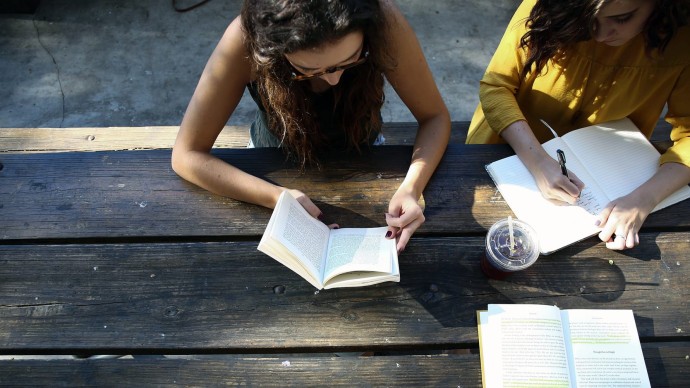
Royal Society of Chemistry referencing
The Royal Society of Chemistry (RSC) style of referencing is used by all students in the Chemistry department.
Why reference?
One of the purposes of referencing is to enable others to find the information that you have used in your assignment.
Also, not referencing the work of others in your assignments is called plagiarism. Plagiarism is a form of academic misconduct.
See the Academic Integrity page for more information.
There is lots of information on how to avoid plagiarism in the Skills Online tutorial on Moodle and the Academic Study Skills videos playlist on YouTube
The RSC referencing style
The RSC referencing style
RSC referencing is expected for our Chemistry students and important to get right. But it doesn’t have to be complicated and we’re here to help.
You can find guidance on how to reference using the Royal Society of Chemistry style on the RSC website
You can also use EndNote referencing management software to help format your references correctly.
Your tutors in the Chemistry Department are also experts on RSC referencing.
For help from librarians please email library@mmu.ac.uk and we will get back to you.
Postgraduate students and researchers
Postgraduate students and researchers
If you are a postgraduate in the Faculty of Science and Engineering, we recommend you speak to your supervisor about which referencing style to use. If you are preparing a publication, have a look at which referencing style the journal or publisher expects you to use.
Video guide
-
Transcript
This video will take you through the principles of referencing using the RSC-style. You should all have access to the RSC Referencing Guide, which is on the page. And it will be a good idea if you have this with you to guide you during this video.
By the end of this video, you will be able to identify the terminology used when we talk about referencing. You’ll be able to understand why you need to cite and reference and what information you need to include within a reference. Finally, I will show you how to get help with RSC referencing.
When you are referencing using the RSC style, all the in-text referencing is done by using a superscript number. This number is usually entered at the end of a sentence after the full stop, as in the example here. But it can also be used after the relevant word or compound.
Your reference list will be at the end of your work. And this is where you will need to list the full details of all the sources of information that you’ve used. This list will be in numerical order according to the order of your citations in the text. All the names of the authors need to be given in the reference list, rather than just listing the first three authors and then posting et al.
So how does this look in practice? You can see a draft report. I have highlighted where the superscript is inserted in yellow to show that they have been inserted after the full stop or after the relevant word or compound. You can also see that each superscript number in the text corresponds to the reference list.
Here are some key rules about listing your reference.
The references are listed at the end of the main body of the text along with any notes.
They should be listed in numerical order, according to the order of citations in the text.
If you use the same reference more than once the original citation number should still be used.
Pause the video and just have a quick think about why you need to cite and reference. The first reason is to acknowledge the research contribution of others and avoiding plagiarism. If you do not acknowledge the authors, then you are essentially passing off their ideas as your own, which is plagiarism. Plagiarism can be committed accidentally or not. Either way, it is plagiarism. Ensure you acknowledge this author and source by correctly citing and referencing the material you have used. In that it is essential to back up your arguments and statements by citing well researched material.
So, this takes us to our next point, citing well researched material provides evidence for your own statements and arguments in your work by acknowledging other’s people’s work. And using well researched materials you are providing the evidence you need to include in your assessment. It also allows others to locate the material you have used. This is important so your tutors can follow up on the sources you have views and assess the evidence if required. It also demonstrates you have read around the topic. And this shows your tutor the breadth and depth of your reading. Tutors have said that the first thing they do when marking an assignment is to check the reference list. Tutors can immediately evaluate the reliability, authority, and credibility of sources by scanning the reference list and recognise the types of sources you have used in your work. And whether they are academic sources such as books and journal articles, or non-academic sources such as web pages. Citation separates the ideas of others from your own. If you are accurately citing all of the sources you have used, it is clear what statements are your own. And of course, it’s standard academic practice. It’s what you’re expected to do at university.
Now referencing in the text, if you’re citing one author in your work, you put the superscript number at the end of the sentence or phrase relating to that particular idea. You don’t put it at the end of the paragraph. Similarly, with two authors, you would list the authors as in the example on the screen. Heywood and Smith. And put the superscript number at the end of the sentence.
When you are citing three or more authors, you need to put et al in italics after the first author’s name and put the superscript number at the end of the sentence.
Have a think about what elements you would put in your reference list if you have referenced a book. So the information you need to include is the author, the title of the book, the year of publication, the place of publication such as Oxford, the publisher such as Oxford University Press, and the edition statement if necessary.
Here’s another quick activity for you. Put this book reference in the right order. Have a look at this reference and decide what order it needs to go in.
The correct answer is 2,5,4,1,6,3. So the reference would read A Burrows, Chemistry 3, introducing inorganic organic and physical chemistry. Oxford University Press, Oxford, third edition, 2017. And always remember if the edition isn’t listed or it’s a first edition. you don’t need to include it.
It is worth focusing on how to add journals to your reference list. Note that the volume number is in bold and you usually have to abbreviate journal titles using the Chemical Abstracts service source index. Remember journals articles can have 1 page or many pages you include the page number or page number range and always remember if you use the same journal article as a reference more that once, the original citation number should still be used.
Here is an example of a reference list. So you can say your reference list shows your tutor the wide range of sources that had been consulted whilst doing your assignment. This shows that you haven’t limited yourself to one particular source. So we have a book , two authors of a book, a journal article (note that is shows the page range). And finally, a webpage. Please remember to add when you access the website so that if the website gets removed or changed, the tutor will know when you have accessed it.
If you need more help with RSC referencing. There is a link to the RSC website on the chemistry subject guide on the library website. Now if you have any questions, please e-mail library@mmu.ac.uk Please make sure you include your course name and student number within your email. And someone will get back to you within one working day. Thank you for watching and please keep in touch with us.


